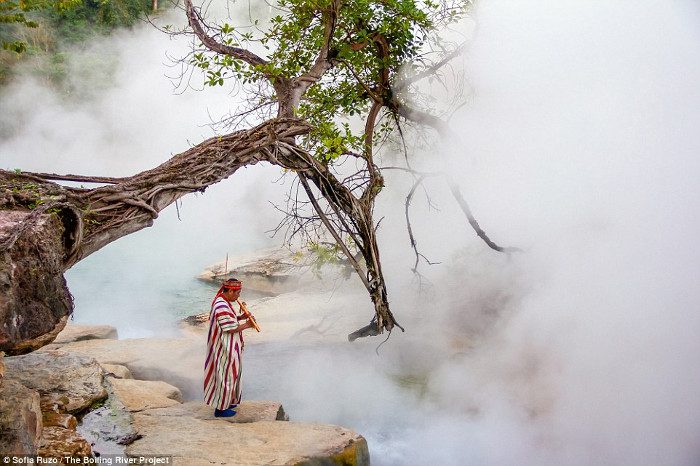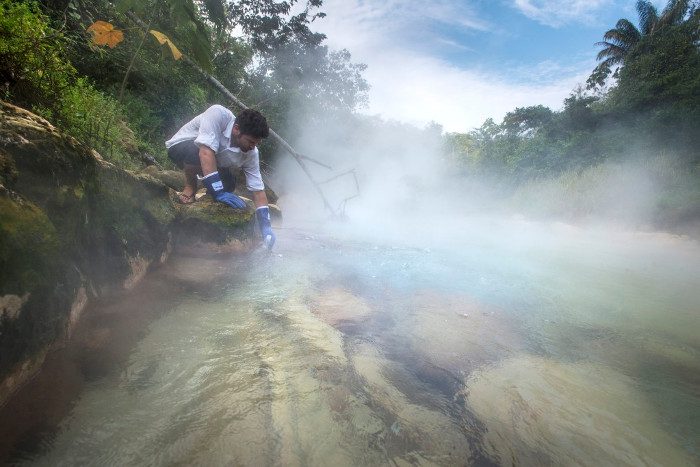The river stretches over 6 km through the Amazon rainforest with an average temperature of 86 degrees Celsius, causing most animals to perish if they accidentally fall into the water.
According to IFL Science, Andrés Ruzo, a Peruvian geophysicist, was the first to pay attention to the boiling river in 2011.
The river has been known to indigenous communities living in the Amazon rainforest for centuries but had not officially appeared on any map. While many questions about the causes of this bizarre phenomenon remain unanswered, Ruzo’s research sheds light on some of the secrets linked to the river.

The name of the river means “boiling with the heat of the Sun” in the local language. (Image: Sofia Ruzo).
Natural hot springs are not a new phenomenon. Geothermal springs exist all over the world, such as in Iceland and Yosemite, USA. These types of springs are usually located near volcanoes, but the boiling river in Peru is more than 700 km away from the nearest volcanic center.
The Shanay-timpishka river, meaning “boiling with the heat of the Sun,” also known as La Bomba in Peru, has been recognized by the indigenous Amazon community for centuries. However, many scholars, authorities, and even the fossil fuel industry are skeptical about its existence. “The most interesting thing is the size of the river. Ultimately, there doesn’t necessarily have to be a volcano for hot springs to form, but when there is no volcano nearby, such springs are often not large enough,” Ruzo commented.
The boiling river stretches 6.24 km and has an average temperature of 86˚C. Since most of the riverbed is wider than a two-lane road, the amount of heat required to raise the entire volume of water to such high temperatures must be enormous. What surprised him was that the upstream part is quite cold. It only warms up as it flows through a hot spring located beneath a rock shaped like a snake’s head. After consulting with a shaman, Ruzo was allowed to study the river and take water samples back to the laboratory.

Andrés Ruzo began researching the river in 2011. (Image: Devlin Gandy).
In an interview, Ruzo stated that the river is hot enough to kill most animals that fall into the water. According to Ruzo, the first part to be destroyed is the eyes, followed by the flesh of the victim starting to be boiled by the river.
A significant question is where the river’s heat originates. Chemical analysis conducted by Ruzo indicates that the river water comes from rainfall. After falling, it is likely that the rainwater seeps deep into the ground, where it is heated by the Earth’s geothermal energy, before flowing into the Amazon rainforest. In other words, the river is part of a massive hydrothermal system.
Ruzo shared that before approaching the river, he suspected it might be caused by an oil or gas well. Although Ruzo reached conclusions after his research, he decided to postpone the announcement until the Peruvian government could take steps to protect the river from illegal exploitation.
For a long time, the river has been associated with folklore, mysticism, and spirituality. Local people regard the river as a sacred site, a connection between humans, the spiritual world, and nature.

The water in the Shanay-timpishka river is hot enough to brew tea. (Image: MudaCom)
The discovery of this boiling river demonstrates that even in the 21st century, there are still some terrestrial natural wonders that remain unexplored. The fact that the forests surrounding the boiling river are facing significant threats from deforestation means that the Peruvian government needs to accelerate efforts to save this area and other unique nearby ecosystems.
Researchers have pressured the Peruvian government to declare the river a national monument and limit access to it, encouraging responsible ecotourism in the region.
Like the rest of the Amazon rainforest, the area surrounding Shanay-timpishka is threatened by deforestation, development projects, and fossil fuel extraction. Ruzo hopes his research will encourage the Peruvian government to find ways to protect the river.


















































